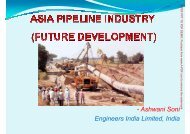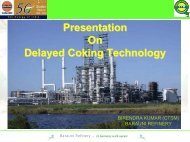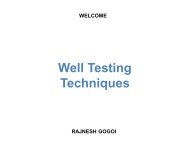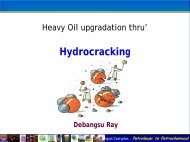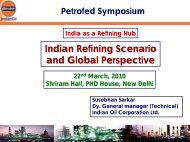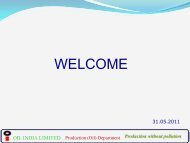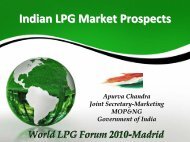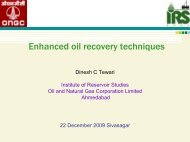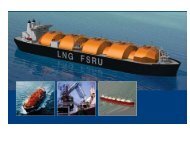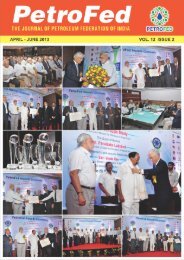Pipeline Inspection and O&M of Pipelines - petrofed.winwinho...
Pipeline Inspection and O&M of Pipelines - petrofed.winwinho...
Pipeline Inspection and O&M of Pipelines - petrofed.winwinho...
Create successful ePaper yourself
Turn your PDF publications into a flip-book with our unique Google optimized e-Paper software.
<strong>Inspection</strong> <strong>of</strong> High Pressure (HP) <strong>Pipeline</strong>sA general Model <strong>of</strong> inspection <strong>of</strong> HP pipelines is indicatedin the next slides.Objective <strong>of</strong> a good <strong>Pipeline</strong> <strong>Inspection</strong> system is :-“To ensure Safe, Reliable <strong>and</strong> Environmentfriendly uninterrupted operations <strong>of</strong> the pipelineSystem”4
Stages <strong>of</strong> <strong>Inspection</strong>5
A Model <strong>Inspection</strong> PlanS.No.Activity1 <strong>Pipeline</strong>Patrolling2 ROW<strong>Inspection</strong>ANSI B31.8(NG) / ANSIB31.4(LPG)NG: Annual (Classlocation1&2)Half yearly (Classlocation 3)Quarterly (Class 4location) (Cl.851.2)LPG: Patrols shall bemade at intervals notexceeding two weeks,except that pipingsystems transportingLPG or liquid anhydrousammonia shall bepatrolled at intervals notexceeding 1 week inindustrial, commercial, orresidential areas.OISD138 OISD 226(NG) / OISD 214 (LPG) TypicalNG: As perANSI B31.4 Cl.851.2(Cl.4.0).LPG: Weekly(urban areas)Monthly (otherareas)Annually(Cl 5.0)NG: Fortnightly (class 3 & 4 )Monthly (Class 1 & 2 )Twice a year pre & postmonsoon by company<strong>of</strong>ficial)(Cl 12.3.2)For PNGGeneral <strong>Inspection</strong>: Daily (Byoperating personnel). Once amonth by Engineer in charge <strong>of</strong>PNG Mktg. company .LPG : Ground Patrolling <strong>of</strong> OnshoreLPG Cross Country<strong>Pipeline</strong>s shall be carried outonce in a weekLine Walk by the <strong>of</strong>ficial <strong>of</strong> thecompany at least once in a yearis required to be conductedafter the monsoon.Quarterly (Road & Highway)Water course crossings Twice ina year (Pre & after monsoon)(Cl. 12.3.1)Daily throughPatrolman,Guards,Annual patrollingin a distributedmanner by <strong>of</strong>ficersOnce in 6months bystation incharge otherwise regular by<strong>of</strong>ficers <strong>of</strong>mainline group6
A Model <strong>Inspection</strong> PlanS.NoActivity ANSI B31.8 OISD138.3 Rail/ Road Greater frequency than QuarterlyBridge & pipelines in open (Cl.6.1)suspendedcountrycrossing (Main Highways & Railroad crossings)4 Road &(Cl.851.2)Greater frequency than QuarterlyHighway pipelines in open(Cl.6.2)crossingcountry(Main Highways & Railroad crossings)(Cl.851.2)5 CleaningPigging6 IntelligentpiggingAnnually (Wet Gas)Once in two years(Dry gas)LPG pipeline (as perOISD 214)(Cl.7.1)Once in 10 years (Cl7.2)OISD 226(NG) / OISD214 (LPG)Quarterly (Road &Highway)Water coursecrossings Twice in ayear (Pre & aftermonsoon)(Cl. 12.3.1)NG:Annual (for wetgas)Once in three years (fordry gas)(Cl.12.3.3)LPG:Once in year(Cl.15.4(i))NG:Once in 10 years(Cl12.3.4)LPG:Once in 10 years(Cl15.4(ii))TypicalOnce in a year bySr. <strong>of</strong>ficersOnce in ayear bysr. <strong>of</strong>ficerQuarterly / needbased but max.interval <strong>of</strong> 3 monthsOnce in 10 years/need based7
A Model <strong>Inspection</strong> PlanS.No. Activity ANSI B31.8 OISD138 OISD 226 Typical7 PSP Measurements Frequency basedon variousparameters(Cl. 862.217)8 PEARSON/ CAT &DCVGFortnightly at feedingpoints (Cl.19.1.i)Quarterly at other locations(Cl.19.1.ii)Once in 5 years(Cl 9.2.1)Fortnightly atfeeding points(Cl.12.3.5.a.i)Quarterly atother locations(Cl.12.3.5.a.ii)Annual On -<strong>of</strong>f(Cl.12.3.5.a.iii)Once in 5 years(Cl12.3.6)Weekly in CPstationQuarterly at TLPSON & 1 on-<strong>of</strong>fIn 6 months max.)Need based butmax in 5 yrs9 CPL survey Once in 5 years(Cl 9.2.2)Once in 5 years(Cl12.3.6)Need based butmax in 5 yrs10 Insulating joint/Coupling inspectionAnnually(Cl. 9.2.3)Once in 5 years(Cl12.3.6)Once in a year<strong>and</strong>Along with PSPmonitoring8
S.No.11 ExternalOverground pipingAnuallyCl. 9.2.412 Soil testing Mentioned-Frequency notdefined13 <strong>Inspection</strong> <strong>of</strong> pipes,valves & fittingsA Model <strong>Inspection</strong> PlanActivity ANSI B31.8 OISD138 OISD 226 TypicalAnuallyCl. 9.2.4As per OISD130(Cl.12.3.8)Once in aquarterNeed basedRegular14 Internal corrossionmonitoringMention <strong>of</strong> InhibitorInjection system,Corrossioncoupons,Corrossion probesexists but n<strong>of</strong>requency defined.(Cl. 863.3)Annual(CorrossionCoupon)(Cl.10.i)Quarterly (ERP)(Cl.10.ii)Once in two years(UT)(Cl.10.iii)No specificdurationdefinedexcept for I.P.Quarterly:CorrosioncouponQuarterly: ERprobeOnce in twoyears: U.Tover groundpiping9
<strong>Pipeline</strong> <strong>Inspection</strong><strong>and</strong> O&M <strong>of</strong> <strong>Pipeline</strong>s10
<strong>Pipeline</strong> <strong>Inspection</strong><strong>and</strong> O&M <strong>of</strong> <strong>Pipeline</strong>sFinally you can end up with this11
<strong>Pipeline</strong> <strong>Inspection</strong><strong>and</strong> O&M <strong>of</strong> <strong>Pipeline</strong>scould have been worse12
A Typical <strong>Pipeline</strong> Wash Out13
Only one particular inspection plan may not besufficient.Experience indicate that absence <strong>of</strong> synthesis <strong>of</strong> data collectionthrough various inspections (by different departments at differenttimes) has been a cause <strong>of</strong> many pipeline failures . Merging <strong>of</strong> data<strong>and</strong> analyzing the same together gives the best possibility <strong>of</strong> safe/failure free (<strong>and</strong> cost effective) operation <strong>of</strong> a pipeline.Realization <strong>of</strong> advantages <strong>of</strong> analyzing the entire data base togetherhas given birth to Risk <strong>and</strong> Integrity management.Every <strong>Pipeline</strong> Operator may have a Risk <strong>and</strong> Integrity ManagementProgramme covering the elements <strong>of</strong> API 1160. Major elements <strong>of</strong>which are indicated in the subsequent slides.14
Elements <strong>of</strong> a typical pipeline integrity management scheme- API 1160Identify potentialimpact to HCAsInitial data gathering,review <strong>and</strong> integrationInitial risk assessmentPerform inspection <strong>and</strong>/or mitigationDevelop baseline planRevise inspection <strong>and</strong>mitigation planEvaluate programUpdate, integrate, <strong>and</strong>review data* HCA= High Consequence AreaReassess riskManage change15
A typical approach to Integrity Management <strong>of</strong><strong>Pipeline</strong> (High Pressure) – Designing inspectionschemes suitable for a particular area rather thanapplying same scheme for the entire pipeline.In the following slides an approach to a model<strong>Pipeline</strong> Integrity Management (PIM) Plan ispresented16
<strong>Pipeline</strong> <strong>Inspection</strong><strong>and</strong> O&M <strong>of</strong> <strong>Pipeline</strong>sA) Time Dependent External Corrosion Internal corrosion Stress Corrosion Cracking17
<strong>Pipeline</strong> <strong>Inspection</strong><strong>and</strong> O&M <strong>of</strong> <strong>Pipeline</strong>sB) Stable Manufacturing Related DefectsDefective pipe seamDefective pipeWelding/Fabrication Related Defective pipe girth weld Defective fabrication weld Wrinkle bend or buckle Stripped threats/broken pipe/coupling failure18
<strong>Pipeline</strong> <strong>Inspection</strong><strong>and</strong> O&M <strong>of</strong> <strong>Pipeline</strong>sEquipment Gasket O-ring failure Control/Relief equipment malfunction Seal/pump packing failure Miscellaneous19
<strong>Pipeline</strong> <strong>Inspection</strong><strong>and</strong> O&M <strong>of</strong> <strong>Pipeline</strong>sC) Time Independent Third Party/Mechanical Damage Incorrect Operations Weather related <strong>and</strong> outside force Cold weather Lightning Heavy rains or floods Earth movements20
<strong>Pipeline</strong> <strong>Inspection</strong><strong>and</strong> O&M <strong>of</strong> <strong>Pipeline</strong>s Internal <strong>Inspection</strong> or Pressure TestStart with the Highest Risk HCA (HighConsequence Area)Complete 50% <strong>of</strong> HCA’s Based on RiskAll HCA’s 100% CompleteExcept for Class 3 or 4 Locations <strong>of</strong> ModerateImpact – 100% Complete21
How to Proceed - A Typical Model Direct AssessmentStart with the Highest Risk HCAComplete 50% <strong>of</strong> All HCA’s Based on Risk byAll HCA’s CompleteExcept for Class 3 or 4 locations <strong>of</strong> ModerateImpact – 100%22
<strong>Pipeline</strong> <strong>Inspection</strong><strong>and</strong> O&M <strong>of</strong> <strong>Pipeline</strong>s Discovery <strong>of</strong> a Condition in an HCA – say 180 Daysto Determine Threat to Integrity Except for Immediate Remediation ConditionsPredicted Failure Pressure < 1.1 x Established MOP atLocationAny Dent with a Stress Raiser Regardless <strong>of</strong> Size orOrientationAn Anomaly that Requires Immediate ActionMust Reduce Operating Pressure to a Safe LevelMust Follow ASME B31.8S, Section 7 or equivalentcode/ practice23
<strong>Pipeline</strong> <strong>Inspection</strong><strong>and</strong> O&M <strong>of</strong> <strong>Pipeline</strong>s 180 Day Remediation ConditionsPlain Dents > 6% <strong>of</strong> OD Regardless <strong>of</strong> OrientationPlain Dents > 2% <strong>of</strong> OD Affecting a Girth Weld orSeam Weld Longer Than 180 Day Remediation Conditions Only If Anomaly Cannot Grow to a Critical Stage Only If Internal <strong>Inspection</strong> used –An Anomaly with a Predicted Failure Pressure > 1.1 xEstablished MOP at Location Any anomalous Condition Not Covered Above24
<strong>Pipeline</strong> <strong>Inspection</strong><strong>and</strong> O&M <strong>of</strong> <strong>Pipeline</strong>sAs Frequently as Needed – Operator Decides But No Longer Than 7 Years Unless A ConfirmatoryDirect Assessment is carried Out› Very Specific Rules Apply› Only Available with Performance Plan Internal <strong>Inspection</strong> or Pressure Test - MaximumPeriods are› 10 Years - Equal to or Greater Than 50% SMYS› 15 Years Equal to or Less Than 50% SMYS Maximum Periods must be Justifiable25
<strong>Pipeline</strong> <strong>Inspection</strong><strong>and</strong> O&M <strong>of</strong> <strong>Pipeline</strong>s Direct Assessment – Maximum Periods are› 5 Years for Remediation by Sampling› 10 Years for Remediation <strong>of</strong> All Anomalies26
<strong>Pipeline</strong> <strong>Inspection</strong><strong>and</strong> O&M <strong>of</strong> <strong>Pipeline</strong>s Identify Company Data Sources for IntegrityManagement Plan (IMP) Development Evaluate Records <strong>and</strong> Procedures for› <strong>Pipeline</strong> Design <strong>and</strong> Construction› <strong>Pipeline</strong> Operation› <strong>Pipeline</strong> Maintenance› Service History› Prior Integrity Assessments Evaluate systems already in place – database, riskassessment, etc. Document Results27
<strong>Pipeline</strong> <strong>Inspection</strong><strong>and</strong> O&M <strong>of</strong> <strong>Pipeline</strong>s Apply Final Rule Definitions <strong>of</strong> HCA’s toSystem to:› Identify HCA Locations <strong>and</strong> Classify› Determine Potential Impact Zones› Justify Non-HCA Locations› Document Results28
<strong>Pipeline</strong> <strong>Inspection</strong><strong>and</strong> O&M <strong>of</strong> <strong>Pipeline</strong>sFocus <strong>of</strong> any <strong>Inspection</strong> <strong>and</strong> Maintenance plan <strong>of</strong>pipelines shall be1. Improved safety <strong>of</strong> pipelinesReduce Number <strong>of</strong> IncidentsReduce likelihood <strong>of</strong> major incidentsMitigate the consequence <strong>of</strong> incidents2. Provide the basis for increased public confidencein pipeline safety29
<strong>Pipeline</strong> <strong>Inspection</strong><strong>and</strong> O&M <strong>of</strong> <strong>Pipeline</strong>s<strong>Inspection</strong> <strong>and</strong> maintenance <strong>of</strong>low pressure pipelines30
<strong>Pipeline</strong> <strong>Inspection</strong><strong>and</strong> O&M <strong>of</strong> <strong>Pipeline</strong>sWhat is a Low Pressure <strong>Pipeline</strong> ?Low pressure (LP) pipelines are those line which runbetween Jetty to tank farm, within tank farm or suchlines that operates within a pressure limit <strong>of</strong> 5to15kg/sq.cm.However, technically a low pressure pipeline is the onethat operates at a pressure corresponding to maximum<strong>of</strong> 30% <strong>of</strong> SMYS, irrespective <strong>of</strong> nature <strong>of</strong> service.31
<strong>Pipeline</strong> <strong>Inspection</strong><strong>and</strong> O&M <strong>of</strong> <strong>Pipeline</strong>sScope <strong>of</strong> this presentation is limited to commonly foundlow pressure (LP) pipelines that run between Jetty totank farm, within tank farm or small diameter gatheringlines.Important aspect in <strong>Inspection</strong> <strong>and</strong> maintenance <strong>of</strong> LPpipelines: During design During construction During commissioning During OperationRequirements are clearly specified in ANSI B 31.3 or API570 <strong>and</strong> OISD guidelines32
<strong>Pipeline</strong> <strong>Inspection</strong><strong>and</strong> O&M <strong>of</strong> <strong>Pipeline</strong>sTypical nature <strong>of</strong> a low pressure pipelineCommonly found in most facilitiesNon- piggable Short lengths Complicated configurations Limited access In some cases operators not muchaware <strong>of</strong> design parameters33
<strong>Pipeline</strong> <strong>Inspection</strong><strong>and</strong> O&M <strong>of</strong> <strong>Pipeline</strong>sTypical nature <strong>of</strong> a low pressure pipelineThere are many different considerations to be givenwhen inspecting buried piping. Some include:1. Piping location, size <strong>and</strong> length2. Accessibility <strong>of</strong> buried portion3. Any value <strong>of</strong> cathodic protection4. Potential for corrosion34
<strong>Pipeline</strong> <strong>Inspection</strong><strong>and</strong> O&M <strong>of</strong> <strong>Pipeline</strong>sTypical nature <strong>of</strong> a low pressure pipelineReviewing past history can provide a wealth <strong>of</strong> information. Years <strong>of</strong> service Past corrosion problems Similar service Changes in service Piping specifications35
Typical nature <strong>of</strong> a low pressure pipeline<strong>Pipeline</strong> <strong>Inspection</strong><strong>and</strong> O&M <strong>of</strong> <strong>Pipeline</strong>s<strong>Inspection</strong> <strong>of</strong> low pressure buried piping typically involves more planning toperform similar inspection in above ground pipelines. Several conditionsarise when performing inspections on buried piping- only the solutions getmore difficult.Some damage mechanisms Erosion/Corrosion Internal/External Coating dis-bondment Inherent mill defects Instability Third Party Damage Soil to Air Interface Environmental cracking36
<strong>Pipeline</strong> <strong>Inspection</strong><strong>and</strong> O&M <strong>of</strong> <strong>Pipeline</strong>sSome important points for LP pipelines for operators:1. Selection <strong>of</strong> pipe grade.2. Welding whether done requirements are in line with APIst<strong>and</strong>ards <strong>and</strong> largely relaxed small contractor3. Hydrostatic testing : <strong>Inspection</strong> during the test <strong>and</strong> recordkeeping is poor.4. Crossings: Ensuring minimum distance is maintained bothvertically <strong>and</strong> horizontally, in line with guidelines available inASME B 31.35. Incorporating new development (e.g., new lines, tanks,buildings etc. ) in the original drawing/ lay out plan37
<strong>Pipeline</strong> <strong>Inspection</strong><strong>and</strong> O&M <strong>of</strong> <strong>Pipeline</strong>sPoints to be considered while drawing inspection scheme:1. Corrosion control –• Corrosion monitoring scheme to be drawn similar to HP lines• <strong>Inspection</strong>s to be done routinely on a fixed time interval.• <strong>Inspection</strong> to be done by a team <strong>of</strong> experienced <strong>and</strong> qualifiedpersonnel• Documentation <strong>and</strong> expert review <strong>of</strong> inspection findings are essential2. Corrosion mitigation measures shall be upgraded / strengthened onthe basis <strong>of</strong> inspection finding only.3. Each small or big failure shall be analyzed <strong>and</strong> documented.4. In case <strong>of</strong> over ground lines visual inspection <strong>and</strong> thickness surveyby qualified personnel shall form a part <strong>of</strong> corrosion monitoringscheme.5. In buried lines provision <strong>of</strong> CP system shall be considered along withproper coating.38
<strong>Pipeline</strong> <strong>Inspection</strong><strong>and</strong> O&M <strong>of</strong> <strong>Pipeline</strong>sOperators <strong>of</strong> low pressure pipelines in marketing terminals, refinery tankfarms <strong>and</strong> other areas may consider developing an inspection schemesimilar to that <strong>of</strong> pressure lines.In accordance with the prevailing regulations a period based inspectionscheme like Monthly, bi-monthly, annually, 3 yearly or 5 yearly etc., shall bedevised <strong>and</strong> put into action., The monthly inspections may include the following:• Signs <strong>of</strong> Corrosion – Visual <strong>Inspection</strong>• Condition <strong>of</strong> coating – Through bell hole• Condition <strong>of</strong> insulation (if required)• Proper operation <strong>of</strong> alarm system• External leak detection monitoring using detection wells <strong>and</strong> ground watermonitoring• Over ground piping not in contact with soil – visual inspection• Condition <strong>of</strong> all above ground valves, <strong>and</strong> flanges in the system.• Impressed current cathodic protection system – tested by a CorrosionPr<strong>of</strong>essional or Cathodic Protection Tester39
<strong>Pipeline</strong> <strong>Inspection</strong><strong>and</strong> O&M <strong>of</strong> <strong>Pipeline</strong>sSome useful codes <strong>and</strong> st<strong>and</strong>ards, that may assist in designing a goodinspection <strong>and</strong> maintenance programme <strong>of</strong> low/high pressure pipelines1. ASME B31.3 : Process Piping2. OISD –149 : <strong>Inspection</strong> <strong>of</strong> cross country pipeline3. API –570 : <strong>Inspection</strong>, repair, alteration, <strong>and</strong> re-rating <strong>of</strong> in- service pipingsystem4. ASME B31.4 : <strong>Pipeline</strong> transportation systems for liquid hydrocarbons <strong>and</strong> otherliquids5. API 1104 : St<strong>and</strong>ard for Welding <strong>Pipeline</strong> <strong>and</strong> Facilities6. ANSI B 31.8 : Gas Transmission <strong>and</strong> Distribution Piping System7. OISD 141 : Design & Const. req. for liquid hydrocarbon pipelines other thanLPG.8. API 1160 : Managing System Integrity for Hazardous Liquid <strong>Pipeline</strong>s9. OISD 214 : LPG <strong>Pipeline</strong>s10. OISD 138 : Onshore <strong>Pipeline</strong>.11. OISD 139 : Offshore <strong>Pipeline</strong>s & SPMs12. OISD 140 : Un loading / loading pipelines at Jetty.13. OISD 188 : Corrosion monitoring for pipelines40
MANAGING SYSTEMINTEGRITY FORHAZARDOUSLIQUID PIPELINES<strong>Pipeline</strong> Integrity Management
INDEX1. Introduction2. Scope3. References4. Terms, definitions <strong>and</strong> acronyms5. Integrity management program6. High consequence areas7. Data gathering, review <strong>and</strong> integration8. Risk assessment implementation9. Initial baseline assessment pl<strong>and</strong>evelopment <strong>and</strong> implementation<strong>Pipeline</strong> Integrity Management
INDEX10. Mitigation options11. Revision <strong>of</strong> the integrity managementplan12. Integrity management <strong>of</strong> pipeline pumpstations <strong>and</strong> terminals13. Program evaluation14. Managing change in an integrityprogram<strong>Pipeline</strong> Integrity Management
PURPOSE AND OBJECTIVESError free, Spill free <strong>and</strong> Incident freeoperation <strong>of</strong> pipeline.Assessing risks <strong>and</strong> its mitigation.Baseline assessments <strong>and</strong> periodicreassessments for continuous upgradation.<strong>Pipeline</strong> Integrity Management
FRAMEWORK FOR AN INTEGRITY MANAGEMENT PROGRAM(SECTION 5)Identify potentialimpact to HCAsInitial data gathering,review <strong>and</strong> integrationInitial risk assessmentPerform inspection <strong>and</strong>/or mitigationDevelop baseline planRevise inspection <strong>and</strong>mitigation planEvaluate programUpdate, integrate, <strong>and</strong>review dataReassess riskManage change<strong>Pipeline</strong> Integrity Management
Identify potential pipeline impacts to HCAs (Section 6)Identification <strong>of</strong> HCAs.Using HCA information for data gathering,risk assessment <strong>and</strong> inspection.Determination <strong>of</strong> pipeline’s effect onHCAs.Documentation <strong>of</strong> HCA data & periodic upgradation.<strong>Pipeline</strong> Integrity Management
DATA GATHERING, REVIEW & INTEGRATION (SECTION7&12) Data collection :› Highest quality <strong>and</strong> consistency.› No decision on suspect data.› Resolution <strong>of</strong> input data.› Never make assumptions.<strong>Pipeline</strong> Integrity Management
DATA GATHERING, REVIEW & INTEGRATION (SECTION7&12)Data sources› Design, material & construction records.› ROW records.› Operation & Maintenance records.› Incident <strong>and</strong> risk reports.<strong>Pipeline</strong> Integrity Management
DATA GATHERING, REVIEW & INTEGRATION (SECTION7&12) Identification <strong>and</strong> location <strong>of</strong> data :› Identifying data needs based on therisk encountered.› Preparation <strong>of</strong> a List <strong>of</strong> data requiredfor integrity assurance.Establishing common referencesystems. Data integration :› Data management systems forintegration.<strong>Pipeline</strong> Integrity Management
RISK ASSESSMENT AND IMPLEMENTATION (SECTION 8)Developing a risk assessmentapproach :› Identify <strong>and</strong> prioritize risks.› Allocation <strong>of</strong> risk mitigation resources.› Selection <strong>of</strong> data based onimportance, completeness, quality <strong>and</strong>timeliness.<strong>Pipeline</strong> risk.› Likelihood› consequences<strong>Pipeline</strong> Integrity Management
RISK ASSESSMENT AND IMPLEMENTATION (SECTION 8)Relative RiskLikelihood <strong>of</strong> FailureConsequences <strong>of</strong> failures……TPDs Corrosion DesignHealth <strong>and</strong>SafetyEnvironmentServiceReliabilityCoating typeCoating ConditionCathodic ProtectionSoil.Type..<strong>Pipeline</strong> Integrity Management
RISK ASSESSMENT AND IMPLEMENTATION (SECTION 8)Assess threats that can reduce thesystem integrity.Assess the environmental <strong>and</strong> externalfactors causing risk.Risk assessment = prediction <strong>of</strong> riskwith the help <strong>of</strong> quality <strong>and</strong> soundinputs.Risk assessment – not a one timeevent.<strong>Pipeline</strong> Integrity Management
RISK ASSESSMENT AND IMPLEMENTATION (SECTION 8)HighConsequencesMediumMedium RiskRegionHighest RiskRegionSimplified Depiction<strong>of</strong> RiskLowLowest RiskRegionLowMediumHighLikelihood <strong>of</strong> occurrence<strong>Pipeline</strong> Integrity Management
INITIAL BASELINE ASSESSMENT PLAN DEVELOPMENT(SECTION 9) Identification <strong>of</strong> appropriate inspectiontechnique. Prioritizing <strong>and</strong> scheduling <strong>of</strong> work. Initial risk assessment determines whichfactors are to be considered <strong>and</strong> theapproach to be followed. Internal inspection tools: Metal loss tool Crack detection tool. Geometry tool.<strong>Pipeline</strong> Integrity Management
INITIAL BASELINE ASSESSMENT PLAN DEVELOPMENTSECTION 9) Hydrostatic testing technique :Underst<strong>and</strong>ing pipeline anomalies<strong>and</strong> defects.Determination <strong>of</strong> inspectioninterval/ frequency.Responding to anomaliesidentified.<strong>Pipeline</strong> Integrity Management
PERFORM INSPECTION AND/ OR MITIGATE OPTIONS(SECTION 10)Prevention <strong>of</strong> third party damage. Improved line marking. Optical or ground intrusion electronic detection. Improved public education. ROW maintenance. Additional pipeline wall thickness.<strong>Pipeline</strong> Integrity Management
PERFORM INSPECTION AND/ OR MITIGATE OPTIONS(SECTION 10)Controlling corrosion.› Monitor & maintenance <strong>of</strong> CP.› Rehabilitation <strong>of</strong> <strong>Pipeline</strong> coatings.Detecting unintended releases.› Reducing volume lost from unintentionalreleases.› Improved emergency response.› Isolation <strong>and</strong> control <strong>of</strong> release sources(EFRD).<strong>Pipeline</strong> Integrity ManagementOperating pressure reduction.
REVISION OF THE INTEGRITY MANAGEMENT PLAN(SECTION 11)Data should be analyzed <strong>and</strong>integrated with the previous collecteddata.Ongoing data integration <strong>and</strong> riskassessment = revision <strong>of</strong> plan<strong>Pipeline</strong> Integrity Management
PROGRAM EVALUATION(SECTION 13)› Internal/external audits.› To check the efficiency <strong>of</strong> the integrity program.Performance measures methodology:› Selected process measures.› Deterioration measures.› Failure measures.› Internal/external comparisons.Performance improvement.<strong>Pipeline</strong> Integrity Management
MANAGING CHANGE(SECTION 14)Changes to the pipeline by theoperator.Changes affecting pipeline by theothers.Recognize changes before or shortlyafter they occur.Ensure that those changes do notcreate risks.Update the affected portion <strong>of</strong> the<strong>Pipeline</strong> Integrity Managementpipeline integrity program.
<strong>Pipeline</strong> <strong>Inspection</strong><strong>and</strong> O&M <strong>of</strong> <strong>Pipeline</strong>sThanks62




